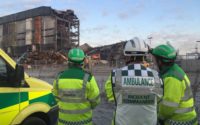Unstable UK Power Structure May Halt Worker Recovery for Months

Ten-story building at the UK power plant site had been set for demolition later in March, officials said.
Photo by Peter Reina for ENR
UK emergency teams may not reach—for months—three demolition workers lost and presumed dead in the tangled mass of steelwork and concrete created by the Feb. 23 catastrophic building collapse at the 2,000-MW Didcot A power plant in southern England.
Demolition experts and engineers, using images gathered remotely by drones and robots, continue investigating safe access into the unstable wreckage mound of the 10-floor boiler building near Didcot, Oxfordshire.
"It will take…in reality, many months before we will be able to get access to those people who are trapped," said Scott Chilton, assistant chief constable at Thames Valley Police, which is leading the investigations with government safety officials.
During a weekend when no work took place at the site, families of the missing workers started an online petition calling on officials to “get these three hard working men out and back home.” They add: “Minutes are turning in to hours, and days are turning in to weeks."
The collapse killed another worker, and injured five. Authorities have not speculated publicly on the cause of the accident.
Meanwhile, while it emerged that the project’s main demolition contractor, Coleman & Company Ltd., Birmingham, had never worked on a major power plant before, the plant owner, utility RWE npower plc, "was made aware that this was our first power station," says Kieran Conaty, Coleman's Didcot project director, in a corporate video.
However, the company recruited experienced managers and subcontractors for the job, he adds. Established by the Coleman family in 1962, the privately owned firm reports annual sales of around $50 million.
Roughly half of the 200-m-long, 45-m-wide boiler house collapsed about two weeks before it was due to be explosively demolished. The building had been emptied and its main steel structure had been weakened by partial cutting of main structural elements ahead of blasting.
The contractor used broadly the same technique to demolish the abutting fuel storage building, which was originally sandwiched between the boiler house’s north side and the turbine hall. Coleman early last year took down the relatively lightweight turbine building and blasted three of the site’s six concrete cooling towers.
Explosives subcontractor Robinson Birdsell Ltd., Wetherby, last September brought down the 13,000-tonne steelwork frame of the fuel storage building using more than 200 kg of explosives, according to the project’s coordinating consultant Stonewells IPS, Tunbridge Wells.
Coleman took over the site in late 2013 and was due to complete demolition by the end of this year, according to the RWE npower.
Starting commercial life in 1970, the coal and oil-fired plant ceased operations three years ago.
Peter Reina reported this story from the site of the collapsed Didcot power station in Oxforshire, England.




